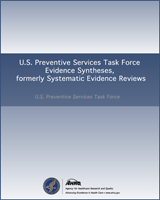NCBI Bookshelf. A service of the National Library of Medicine, National Institutes of Health.
Structured Abstract
Context:
Developmental dysplasia of the hip (DDH) can lead to the later development of chronic pain, osteoarthritis, and limitations in activity. Screening for DDH has been practiced for over 40 years, but recommendations from major professional societies differ.
Objective:
To synthesize the evidence on risks and benefits of screening for DDH.
Data Sources:
MEDLINE (through Sept, 2004), Cochrane CENTRAL, and previous comprehensive literature reviews.
Study Selection:
We focused our review on information gaps identified in previous reviews conducted for the American Academy of Pediatrics and the Canadian Task Force on Preventive Health Care. Specifically, we focused on comparative studies of clinical examination vs. ultrasound screening; studies of the effect of nonsurgical and surgical treatments for DDH on functional outcomes; and studies reporting rates of avascular necrosis with different interventions.
Data Extraction:
Using present criteria, the authors assessed the quality of included trials and abstracted information about settings, patients, interventions, and outcomes.
Data Synthesis:
No published trials directly link screening to improved functional outcomes. Clinical examination and ultrasound identify somewhat different groups of newborns at risk for DDH; the lack of an untreated cohort or definitive gold standard made it impossible to estimate sensitivity and specificity for the different tests. Few studies examine the functional outcomes of patients who have undergone therapy for DDH. Due to the high rate and unpredictable nature of spontaneous resolution of DDH and the absence of comparative studies of intervention vs. no intervention, the effectiveness of interventions is not known. Avascular necrosis (AVN) of the hip, the most common and most severe harm of all treatments for DDH, can result in growth arrest of the hip and eventual joint destruction with significant disability. Reported rates of AVN very widely.
Conclusion:
Screening with clinical examination or ultrasound can identify newborns at risk for DDH, but due to the high rate of spontaneous resolution of neonatal hip instability and dysplasia and the lack of evidence of the effectiveness of interventions on functional outcomes, the net benefits of screening are not clear.
Key Words:
DDH, Hip Dysplasia, mass screening
Prepared for: Agency for Healthcare Research and Quality, U.S. Department of Health and Human Services.1 Contract No. 290-02-0024. Prepared by: Oregon Evidence-based Practice Center.2
This report may be used, in whole or in part, as the basis for development of clinical practice guidelines and other quality enhancement tools, or a basis for reimbursement and coverage policies. AHRQ or U.S. Department of Health and Human Services endorsement of such derivative products may not be stated or implied.
AHRQ is the lead Federal agency charged with supporting research designed to improve the quality of health care, reduce its cost, address patient safety and medical errors, and broaden access to essential services. AHRQ sponsors and conducts research that provides evidence-based information on health care outcomes; quality; and cost, use, and access. The information helps health care decisionmakers—patients and clinicians, health system leaders, and policymakers—make more informed decisions and improve the quality of health care services.
The authors of this article are responsible for its contents, including any clinical or treatment recommendations. No statement in this article should be construed as an official position of the Agency for Healthcare Research and Quality or the U.S. Department of Health and Human Services.
- 1
540 Gaither Road, Rockville, MD 20850. www
.ahrq.gov - 2
Oregon Health and Science University, 3181 SW Sam Jackson Park Road, Portland, Oregon 97239.
- NLM CatalogRelated NLM Catalog Entries
- Review Screening for developmental dysplasia of the hip: a systematic literature review for the US Preventive Services Task Force.[Pediatrics. 2006]Review Screening for developmental dysplasia of the hip: a systematic literature review for the US Preventive Services Task Force.Shipman SA, Helfand M, Moyer VA, Yawn BP. Pediatrics. 2006 Mar; 117(3):e557-76.
- Review Cochrane Review: Screening programmes for developmental dysplasia of the hip in newborn infants.[Evid Based Child Health. 2013]Review Cochrane Review: Screening programmes for developmental dysplasia of the hip in newborn infants.Shorter D, Hong T, Osborn DA. Evid Based Child Health. 2013 Jan; 8(1):11-54.
- Review Preventive health care, 2001 update: screening and management of developmental dysplasia of the hip in newborns.[CMAJ. 2001]Review Preventive health care, 2001 update: screening and management of developmental dysplasia of the hip in newborns.Patel H, Canadian Task Force on Preventive Health Care. CMAJ. 2001 Jun 12; 164(12):1669-77.
- [Wagner stockings for the treatment of developmental dysplasia of the hip diagnosed early by general screening].[Acta Chir Orthop Traumatol Cec...][Wagner stockings for the treatment of developmental dysplasia of the hip diagnosed early by general screening].Pach M, Kamínek P, Mikulík J. Acta Chir Orthop Traumatol Cech. 2008 Aug; 75(4):277-81.
- Review Screening and Interventions for Childhood Overweight[ 2005]Review Screening and Interventions for Childhood OverweightWhitlock EP, Williams SB, Gold R, Smith P, Shipman S. 2005 Jul
- Screening for Developmental Dysplasia of the HipScreening for Developmental Dysplasia of the Hip
- SRS2430227 (4)SRA
- ribulose-1,5-bisphosphate carboxylase/oxygenase large subunit, partial (chloropl...ribulose-1,5-bisphosphate carboxylase/oxygenase large subunit, partial (chloroplast) [Porana sp. SH-2010]gi|306481305|dbj|BAJ16757.1|Protein
- I2-NBS domain protein, partial [Solanum peruvianum]I2-NBS domain protein, partial [Solanum peruvianum]gi|298110486|gb|ADI57483.1|Protein
Your browsing activity is empty.
Activity recording is turned off.
See more...
